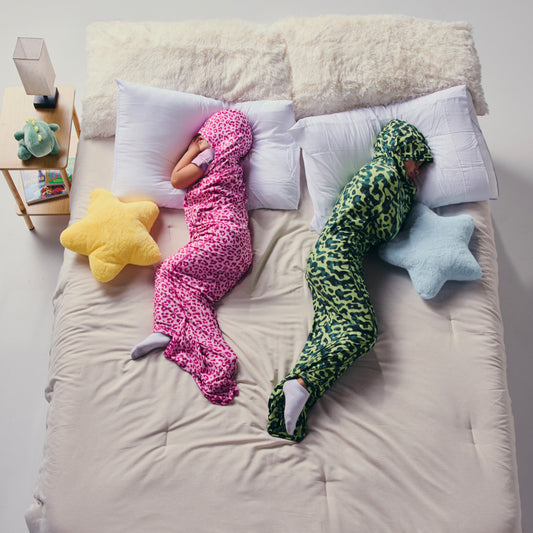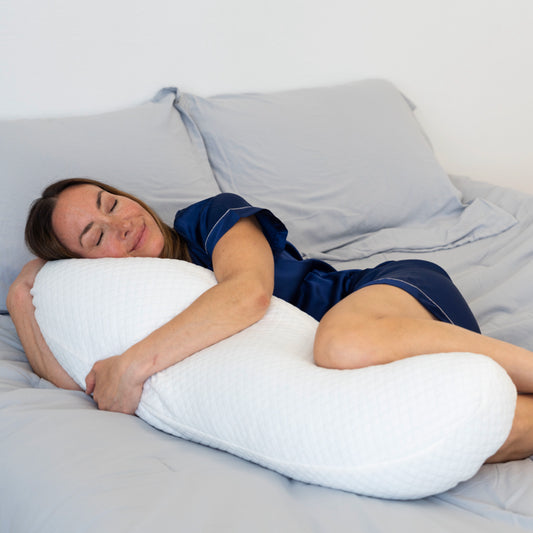Let’s be honest. Most of us aren’t incredibly particular about what we wear to bed. Unless we’re in a new relationship or headed for a honeymoon, our bedroom attire probably consists of old T-shirts and well-worn shorts or undies.
It’s not that we don’t care about our bedtime fashion; it’s just that we want the most comfortable garments possible for sleeping. If what we wear to bed isn’t supremely relaxing, it could cost us some zzzs, something most of us aren’t willing to give up.
The team at Hug Sleep understands that comfort is king when it comes to bedtime. No matter what your favorite type of pajamas may be, they need to fit properly and not interfere with your rest.
Let’s talk about options: what’s available in sleepwear, how those options compare, and what you should wear to get comfortable in bed. We’ll also cover the big question that everyone’s secretly wondering: whether or not you should sleep in the nude!
Checking Out the Options
Maybe you grew up with matching pajama sets and haven’t changed your style since. The classic matching top and bottom set works for a lot of people. But many of us tend to shed layers of pajamas as we get older, opting instead for lighter layers and thinner fabrics.
Here’s a rundown of what’s available for nighttime fashion.
- Classic pajama sets. PJ royalty, these button-down sets are proper bedtime fashion and have stood the test of time.
- T-shirt and shorts. Laid back, comfortable, and effortless, this bedtime standard is tough to go wrong with.
- Sweatpants and sweatshirts. For the sleeper who’s always cold, this is a viable option for any season.
- Underwear. Easy, comfortable, and arguably something you’d wear under any other set of pajamas, wearing only undies to bed can keep you cool and help you avoid additional loads of laundry.
- Nightgowns. The comfort of an easy cotton summer dress, but make it for bed. Nightgowns are popular with both kids and adults.
- Lingerie. Whether you don it only on special occasions or sleep in it nightly, lingerie is a solid option as long as you pick pieces that are comfortable.
- Footie pajamas. A throwback to your childhood, footie pajamas help keep your feet toasty when it’s cold.
- Thermal underwear. The solution for sleeping in the woods, camping, or surviving your significant other’s obsession with the air conditioner.
- Nude. Sleeping in your birthday suit is more popular than you realize, with nearly ⅔ of people choosing nothing at all as the perfect bedtime attire.
When it comes to sleep attire, the options are many. Deciding which is best for you depends on which you find most comfortable and easiest to sleep in.
The last thing you need, however, is to wake up with fabric that bunches or causes you to sweat. A huge factor that impacts your sleepwear decision? Fabric.
Which Fabrics Are Best
We know that Egyptian cotton is the gold standard for bedsheets, and Turkish cotton makes an incredibly absorbent bath towel, but what fabric works best for pajamas?
The answer depends on your own core body temperature, the season, and your overall comfort with the sensory experience the fabric provides.
- Cotton. Cotton is lightweight and breathable. Egyptian cotton works well for pajamas, just like it does with bedsheets. Cotton is easy to care for, and it usually helps keep you cool or warm depending on the season.
- Silk. Silk feels wonderful against the skin, but it isn’t known for its breathability. If you’re a hot sleeper, silk could cause you to sweat.
- Bamboo. An alternative to cotton, bamboo is incredibly breathable, wicks away moisture from sweat, and is hypoallergenic. Bamboo is a great choice if you have sensitive skin or would like to avoid using cotton.
- Wool. Unless you live in extremely cold temperatures, you’ll likely never wear wool pajamas. Merino wool pajamas are one option; much lighter than a wool sweater, they’re specifically designed to trap your body heat and keep you warm.
- Linen. Linen is lightweight and comfortable, but wrinkly. You might find that linen pajamas bunch or twist, making them a nonviable option.
- Flannel. Everyone loves a pair of flannel PJs during cold months. Flannel works well as a lightweight fabric that also helps keep you warm without suffocating your skin.
Your quest for the perfect pajama fabric may lead you to several different types of pajamas based on the season.
Tackling how to stay comfortable in bed no matter the temperature means having the right gear for the job.
How To Stay Cool When It’s Hot
Sleep experts agree that the optimum temperature for your bedroom should be between 60 and 70 degrees Fahrenheit. If the thought of that energy bill makes you shiver, opt for lightweight pajamas in either cotton, bamboo, or linen to survive the summer months and stay comfortably cool.
Baby, It’s Cold Outside
When temperatures drop, your need for warmer nighttime clothing rises. The problem is, some fabrics keep you so warm that they feel intense with indoor heating.
Unless you’re sleeping somewhere outside or without the heat turned up, pass on wool and thermal options. Instead, flannel is an excellent choice for keeping warm without roasting.
Bedtime: What Not To Wear
No matter the temperature, there are some pajamas that shouldn’t even be in existence. As cute as they may be, the below types of fabrics and pieces just aren’t conducive to getting good quality sleep.
Pick these, and you’ll be so tired the next day you might forget how to match your socks.
- Scratchy fabric. Tweed, lace, and some types of wool are no-go’s for sleeping. These fabrics are itchy and can be incredibly uncomfortable.
- Spandex. What it does for you in the gym is amazing. In the bed, it just makes you sweat and feels incredibly constricting. The same goes for tight clothing in general — just avoid it at bedtime.
- Excessively baggy clothing. While tight clothes constrict, incredibly baggy clothing may bunch or twist and wake you up in the middle of the night. Properly fitting pajamas are the best option.
If selecting the right sleepwear seems too complicated, give sleeping in the buff a try.
No Pajamas Required
Sleeping nude isn’t new or trendy. In fact, it’s a time-honored tradition. Pajamas were invented in the late 17th century, but only the extremely wealthy wore them at that time. Sleeping in the buff still reigned until the 1900s.
If you choose to sleep sans clothing, there could be some benefits.
- You’ll stay cool. Sleeping in the buff can help keep your core body temperature lower.
- Reduced risk of yeast infections. Sleeping gives your nether regions a break from undies, allowing airflow and helping reduce the risk of moisture and bacteria.
- It might make you more comfortable. If sleeping in the nude is comfortable for you and allows you to sleep better, it's a definite win.
However, if you’re more comfortable with clothes on, there’s a good argument to support your case also.
- Privacy. Living with children or a roommate? Keep your undies on to avoid awkward situations.
- Cleanliness. You’ll need to invest in a few extra sets of sheets if you plan to sleep naked on a regular basis. Your sheets should be changed every few days if you sleep nude.
- Extra showers. Taking a shower before you go to bed will keep your sheets cleaner and save you some trips to the laundromat.
Ultimately, sleeping naked isn’t objectively right or wrong. If it’s comfortable for you and allows you to sleep, go for it.
What About a Blanket?
There’s something about a favorite blanket that gives us all a sense of comfort and security. Although we’ve outgrown the trusted security blankets we had as kids, we can still get the same kind of warm embrace those blankets gave us in a brand-new grownup version.
Deep Touch Pressure Therapy and Blankets
If you’ve ever tried a weighted blanket, you’re familiar with deep touch pressure therapy, or DTPT, even if you don’t know it.
This science of sensory touch is sometimes referred to as deep touch pressure stimulation. Through the use of touch, DTPT relaxes the body and mind by helping your central nervous system switch from “fight or flight” to “rest and digest.”
How DTPT Works
The fight or flight reaction stems from humans’ sympathetic nervous system, or SNS. That reaction helps keep us alert, reactive, and responsive to threats during the day. The SNS is responsible for triggering the release of adrenaline and cortisol, raising our blood pressure, and elevating our heart rate. Feelings of stress, worry, and nervousness are all produced by the SNS.
The rest and digest experiences come from the parasympathetic nervous system, or the PSNS. The PSNS is the counterbalance of the SNS, relaxing our muscles, slowing our heart rates, and causing us to relax. The PSNS also triggers the release of hormones like serotonin and dopamine. In order for sleep to happen, the PSNS needs to come on shift.
By applying gentle pressure to the body — similar to the type of pressure you’d receive in a tight squeeze — sensory receptors in your skin respond and fire up sensory pathways in your brain. This helps signal your SNS to slow down and your PSNS to engage.
When your body can relax, you’re better able to ease into rest comfortably. For this reason, some people opt for weighted blankets to provide DTPT and stimulate the PSNS at bedtime.
Unfortunately, weighted blankets aren’t a great option for everyone. They can be heavy and hot, a sensation many people find restricting and suppressive.
A solution? The Hug Sleep Sleep Pod.
A Better Blanket
The Hug Sleep Sleep Pod was designed to deliver gentle pressure all over your body via a breathable, four-way stretch fabric that allows for complete mobility and comfort. The experience of wearing a blanket that hugs you back is a sensory experience most people enjoy.
Unlike a weighted blanket that uses the weight of internal pellets and materials to deliver pressure, the Hug Sleep Sleep Pod uses gentle compression provided by the fabric itself. That way, you can stay cool, shift positions easily in your sleep, and retain all the sensory stimulation your body needs.
The Most Comfortable Piece in Your Wardrobe
Whether you sleep in T-shirts and shorts, nightgowns, or even the buff, there’s no better way to finish your bedtime look than by wrapping up in the only cozy, wearable blanket that hugs you back.
When you need to get comfortable before bed, trust the Hug Sleep Pod to keep you cool, comforted, and gently held all night.
Sources:
The Temperature Dependence of Sleep | PubMed
Study: Two-Thirds of Millennials Sleep Nude | USA Today

































400,000+ happy customers